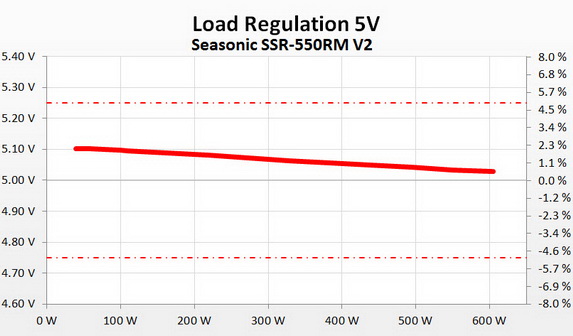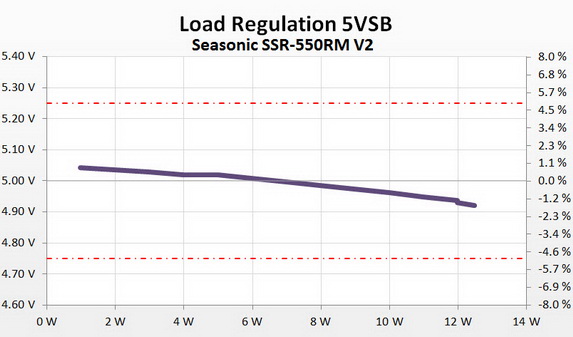 16
16
Seasonic G Series V2 550 W Review
Efficiency, Temperatures & Noise »Test Setup

All measurements were performed using two Chroma 6314A mainframes equipped with the following electronic loads: six 63123A [350 W each], one 63102A [100 W x2], and one 63101A [200 W]. The aforementioned equipment is able to deliver 2500 W of load, and all loads are controlled by a custom-made software. We also used a Rigol DS2072A oscilloscope kindly sponsored by Batronix, a Picoscope 3424 oscilloscope, a Picotech TC-08 thermocouple data logger, two Fluke multimeters (models 289 and 175), and a Yokogawa WT210 power meter. We also included a wooden box, which, along with some heating elements, was used as a hot box. Finally, we had at our disposal three more oscilloscopes (Rigol VS5042, Stingray DS1M12, and a second Picoscope 3424), and a Class 1 Bruel & kjaer 2250-L G4 Sound Analyzer which is equipped with a type 4189 microphone that features a 16.6 - 140 dBA-weighted dynamic range. You will find more details about our equipment and the review methodology we follow in this article. We also conduct all of our tests at 40°C-45°C ambient to simulate the environment seen inside a typical system with a higher accuracy, with 40°C-45°C being derived from a standard ambient assumption of 23°C and 17°C-22°C being added for the typical temperature rise within a system.
Primary Rails Voltage Regulation
The following charts show the voltage values of the main rails, recorded over a range from 60 W to the maximum specified load, and the deviation (in percent) for the same load range.





5VSB Regulation
The following chart shows how the 5VSB rail deals with the load we throw at it.

Hold-up Time
Hold-up time is a very important PSU characteristic and represents the amount of time, usually measured in milliseconds, a PSU can maintain output regulations as defined by the ATX spec without input power. In other words, it is the amount of time the system can continue to run without shutting down or rebooting during a power interruption. The ATX specification sets the minimum hold-up time to 16 ms with the maximum continuous output load. In the following screenshot, the blue line is the mains signal and the yellow line is the "Power Good" signal. The latter is de-asserted to a low state when any of the +12V, 5V, or 3.3V output voltages fall below the undervoltage threshold, or after the mains power has been removed for a sufficiently long time to guarantee that the PSU cannot operate anymore.

Even though it uses a smaller bulk cap, the unit achieves a higher hold-up time than its predecessor. Seasonic informed us that they made a couple changes which increased the hold-up time despite the use of a smaller cap in the APFC.
Inrush Current
Inrush current or switch-on surge refers to the maximum, instantaneous input-current drawn by an electrical device when it is first turned on. Because of the charging current of the APFC capacitor(s), PSUs produce large inrush-current right as they are turned on. Large inrush current can cause the tripping of circuit breakers and fuses and may also damage switches, relays, and bridge rectifiers; as a result, the lower a PSU's inrush current right as it is turned on, the better.
Inrush current was a little lower than with the previous generation G-550 because of the smaller bulk cap.
Voltage Regulation and Efficiency Measurements
The first set of tests revealed the stability of the voltage rails and the efficiency of the G-550. The applied load was approximately equal to 10%-110 % of the maximum load the PSU can handle, in 10% increments.We conducted two additional tests. In the first test, we stressed the two minor rails (5V and 3.3V) with a high load while the load at +12V was only 0.10 A. This test reveals whether the PSU is Haswell ready or not. In the second test, we dialed the highest load the +12V rail can handle while the load on the minor rails was minimal.
| Voltage Regulation & Efficiency Testing Data - Seasonic SSR-550RM V2 | ||||||||||
|---|---|---|---|---|---|---|---|---|---|---|
| Test | 12 V | 5 V | 3.3 V | 5VSB | Power (DC/AC) | Efficiency | Fan Speed | Fan Noise | Temp (In/Out) | PF/AC Volts |
| 10% Load | 2.704A | 1.955A | 1.955A | 0.995A | 54.71W | 82.28% | 755 RPM | 30.3 dBA | 36.89°C | 0.882 |
| 12.260V | 5.103V | 3.372V | 5.019V | 66.49W | 38.71°C | 230.2V | ||||
| 20% Load | 6.446A | 2.936A | 2.941A | 1.195A | 109.74W | 88.24% | 755 RPM | 30.3 dBA | 37.43°C | 0.955 |
| 12.241V | 5.094V | 3.363V | 5.008V | 124.36W | 39.45°C | 230.2V | ||||
| 30% Load | 10.530A | 3.434A | 3.452A | 1.401A | 164.79W | 90.21% | 790 RPM | 31.7 dBA | 38.09°C | 0.979 |
| 12.225V | 5.088V | 3.356V | 4.996V | 182.68W | 40.28°C | 230.2V | ||||
| 40% Load | 14.630A | 3.931A | 3.938A | 1.601A | 219.75W | 90.88% | 1430 RPM | 43.3 dBA | 40.03°C | 0.987 |
| 12.208V | 5.081V | 3.351V | 4.985V | 241.80W | 41.52°C | 230.2V | ||||
| 50% Load | 18.397A | 4.925A | 4.935A | 1.806A | 274.71W | 90.82% | 2120 RPM | 47.3 dBA | 41.68°C | 0.992 |
| 12.190V | 5.073V | 3.341V | 4.973V | 302.49W | 43.55°C | 230.2V | ||||
| 60% Load | 22.176A | 5.919A | 5.935A | 2.015A | 329.69W | 90.67% | 2190 RPM | 48.1 dBA | 41.83°C | 0.995 |
| 12.172V | 5.064V | 3.334V | 4.962V | 363.62W | 44.04°C | 230.2V | ||||
| 70% Load | 25.966A | 6.921A | 6.944A | 2.220A | 384.68W | 90.46% | 2200 RPM | 48.2 dBA | 43.14°C | 0.995 |
| 12.155V | 5.057V | 3.324V | 4.948V | 425.24W | 45.78°C | 230.2V | ||||
| 80% Load | 29.763A | 7.917A | 7.959A | 2.429A | 439.56W | 90.16% | 2200 RPM | 48.2 dBA | 43.60°C | 0.996 |
| 12.136V | 5.049V | 3.316V | 4.937V | 487.54W | 46.59°C | 230.1V | ||||
| 90% Load | 33.998A | 8.432A | 8.492A | 2.431A | 494.63W | 89.90% | 2215 RPM | 48.4 dBA | 44.71°C | 0.996 |
| 12.119V | 5.042V | 3.310V | 4.931V | 550.21W | 48.08°C | 230.1V | ||||
| 100% Load | 38.200A | 8.935A | 8.997A | 2.539A | 549.47W | 89.43% | 2215 RPM | 48.4 dBA | 45.34°C | 0.997 |
| 12.102V | 5.034V | 3.301V | 4.920V | 614.40W | 48.99°C | 230.1V | ||||
| 110% Load | 42.813A | 8.948A | 9.012A | 2.542A | 604.44W | 88.89% | 2215 RPM | 48.4 dBA | 45.93°C | 0.997 |
| 12.082V | 5.028V | 3.295V | 4.913V | 680.00W | 50.10°C | 230.1V | ||||
| Crossload 1 | 0.099A | 12.005A | 12.005A | 0.003A | 102.08W | 83.50% | 2190 RPM | 48.1 dBA | 43.90°C | 0.952 |
| 12.247V | 5.068V | 3.333V | 5.025V | 122.25W | 46.95°C | 230.3V | ||||
| Crossload 2 | 44.978A | 1.002A | 1.003A | 1.002A | 557.59W | 90.10% | 2215 RPM | 48.4 dBA | 45.22°C | 0.997 |
| 12.099V | 5.060V | 3.331V | 4.975V | 618.85W | 49.15°C | 230.1V | ||||
Apr 23rd, 2024 11:24 EDT
change timezone
Latest GPU Drivers
New Forum Posts
- Is there a technical reason that Windows 11 doesn't have built into it battery charge limitation? (29)
- Core PL1 + GPU PL1 + Ring EDP OTHER (4)
- 5.1 or 7.1 software solutions (1)
- FINAL FANTASY XIV: Dawntrail Official Benchmark (64)
- What's your latest tech purchase? (20297)
- SOYO RX580 2048SP Original Bios (8)
- Unlock the shaders - AMD Radeon RX 560D (323)
- Possible near-future 2024 Arrow Lake build.... (49)
- What are you playing? (20521)
- Windows 12 (142)
Popular Reviews
- Horizon Forbidden West Performance Benchmark Review - 30 GPUs Tested
- Fractal Design Terra Review
- Corsair 2000D Airflow Review
- Thermalright Phantom Spirit 120 EVO Review
- Minisforum EliteMini UM780 XTX (AMD Ryzen 7 7840HS) Review
- ASUS GeForce RTX 4090 STRIX OC Review
- NVIDIA GeForce RTX 4090 Founders Edition Review - Impressive Performance
- ASUS GeForce RTX 4090 Matrix Platinum Review - The RTX 4090 Ti
- Creative Pebble X Plus Review
- MSI GeForce RTX 4090 Gaming X Trio Review
Controversial News Posts
- Sony PlayStation 5 Pro Specifications Confirmed, Console Arrives Before Holidays (116)
- NVIDIA Points Intel Raptor Lake CPU Users to Get Help from Intel Amid System Instability Issues (105)
- AMD "Strix Halo" Zen 5 Mobile Processor Pictured: Chiplet-based, Uses 256-bit LPDDR5X (101)
- US Government Wants Nuclear Plants to Offload AI Data Center Expansion (98)
- Windows 10 Security Updates to Cost $61 After 2025, $427 by 2028 (84)
- Developers of Outpost Infinity Siege Recommend Underclocking i9-13900K and i9-14900K for Stability on Machines with RTX 4090 (82)
- TechPowerUp Hiring: Reviewers Wanted for Motherboards, Laptops, Gaming Handhelds and Prebuilt Desktops (74)
- Intel Realizes the Only Way to Save x86 is to Democratize it, Reopens x86 IP Licensing (70)
